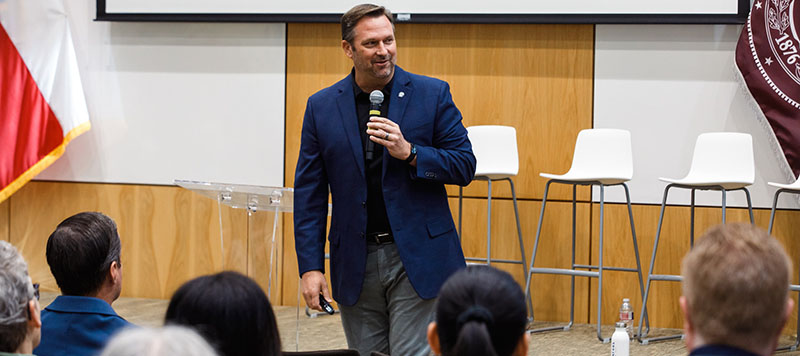
Above: Dr. Mark Milliron speaks to a gathering of faculty and staff at Texas A&M University–Central Texas’ spring convocation on Thursday. Milliron spoke on adopting a “new possible” mindset. Classes begin at A&M–Central Texas on Jan. 16.
In his first convocation at Texas A&M University–Central Texas, Interim President Dr. Richard Rhodes flipped the script from previous years and used the time not to report on the state of the university, but to focus on future outcomes.
Held Thursday morning in the Bill Yowell Conference Center on the A&M–Central Texas campus, Rhodes led a student panel discussion designed to impress upon faculty and staff the importance of what they do and who they serve, as well as challenge them to continue focusing on students and improving the student experience.
Rhodes then introduced guest speaker Mark Milliron, Ph.D., president and CEO of National University, who introduced faculty and staff to the idea of a “New Possible,” and having a worldview that is “constructive and useful.”
Milliron referenced the last few years and the major influence that things such as the pandemic shutdown, social justice issues and political upheaval have had in changing the approach to higher education. He noted how the change and future of higher education is a reflection of society.
“So many people keep saying, ‘Can’t we just get back to normal,’” he said. “The fact is, normal wasn’t working for a whole lot of people.”
Instead of a “new normal,” which has become a post-pandemic catch phrase, Milliron said the focus should be on a “new possible” and accepting the challenges that are coming with innovations such as augmented and virtual reality and artificial intelligence. He pointed to the mid 1990s when stalwarts of education were opposed to the idea of a World Wide Web and organizations having websites where information was stored and available to the public. But like it or not, the internet was here to stay and has since become a major component in business, life and education.
Milliron said the “new possible” focuses on three areas: infrastructure, design, and models. Infrastructure deals with accepting and leveraging new technologies and using them to enhance the classroom experience. How education can work with artificial intelligence instead of trying to keep it out of the classroom.
Design thinking changes the approach to problem solving. Instead of simply finding solutions, it deals with finding user friendly solutions that are more acceptable to the intended audience. He discussed the development of MRI technology. The idea was to build a device that would allow doctors to get the best possible image of the body but it originally did not take into consideration the user experience. When MRIs were first introduced, they had a high failure rate due to the claustrophobic experience as patients were unable to stay in the machine long enough for it to complete its function. Now, through design thinking, the MRI experience is considerably more comfortable and, therefore, more successful.
The final area of consideration is models and determining what is the best approach to achieve the desired outcomes. He said education is seeing a shift from focusing on grades and test scores, to focusing more on content mastery. It is becoming increasingly beneficial to have students exhibit content mastery, looking at things such as critical thinking and problem-solving skills, as opposed to scoring high on an exam.
In essence, Milliron said, moving forward, it is important for education to focus on what is possible, provide students what they need and “design something that makes an impact.”
